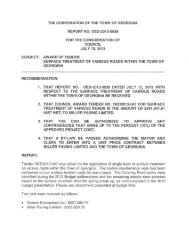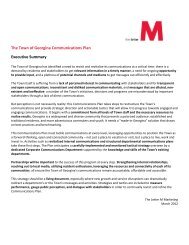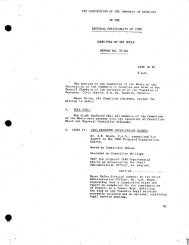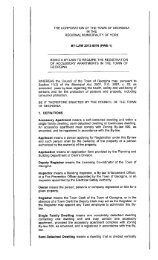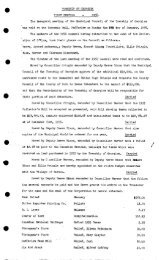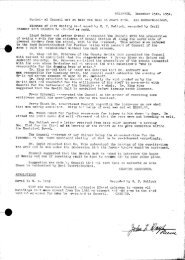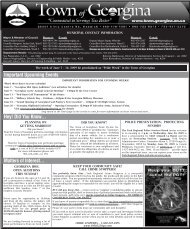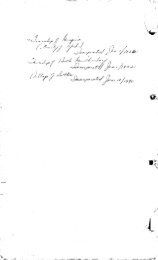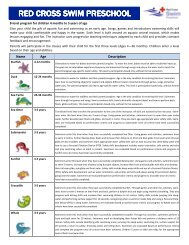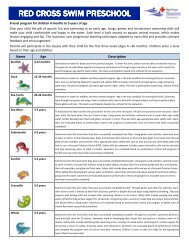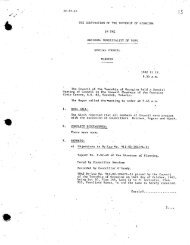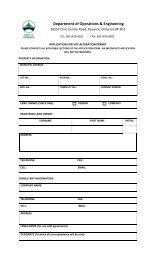Background Report - Town of Georgina
Background Report - Town of Georgina
Background Report - Town of Georgina
You also want an ePaper? Increase the reach of your titles
YUMPU automatically turns print PDFs into web optimized ePapers that Google loves.
TOWN OF GEORGINA, SUTTON SECONDARY PLAN REVIEW STUDY<br />
BACKGROUND REPORT<br />
2.2 EXISTING ENVIRONMENTAL CONDITIONS AND<br />
OPPORTUNITIES / CONSTRAINTS ANALYSIS SUMMARY<br />
Study Approach<br />
An analysis <strong>of</strong> existing environmental conditions was conducted <strong>of</strong> the Study Area. It consisted <strong>of</strong> background<br />
data review (reports, mapping), windshield surveys and airphoto interpretation. This information was used to<br />
develop a Natural Heritage System (environmental framework) for the Sutton Secondary Plan Review Study.<br />
Furthermore, the results were used to:<br />
• characterize and map the natural environment features / functions within and adjacent to the Study Area;<br />
• identify opportunities / constraints to future urban land use; and,<br />
• identify habitat restoration/enhancement opportunities, including buffers and corridor/linkage enhancements.<br />
The existing conditions overview included the areas <strong>of</strong> Vegetation, Wildlife, Fisheries, Corridors/Linkages, Environmental<br />
Policy Areas, LSRCA Regulation Area, Significant Woodlands, the Greenbelt Plan and Natural Hazards<br />
and Lake Simcoe Shoreline. The opportunities and constraints overview that follows, identifies levels <strong>of</strong><br />
environmental constraints (Levels 1, 2, and 3), and their criteria, and an additional level <strong>of</strong> low constraint (Level<br />
4) which consists <strong>of</strong> existing developed areas, agricultural lands and cultural vegetation. The full report and<br />
analysis is contained in Appendix B.<br />
Existing Conditions Overview<br />
In terms <strong>of</strong> existing vegetation, the Study Area consists <strong>of</strong> meadow, shrub thicket and woodland communities that<br />
have largely established on former agricultural lands. Terrestrial features include deciduous, mixed and coniferous<br />
forest associations <strong>of</strong> varying species composition, age structure and disturbance history. Wetlands within<br />
the Study Area consist <strong>of</strong> swamp (coniferous, mixed, deciduous, shrub thicket), marsh (meadow, open water) and<br />
aquatic communities associated with areas <strong>of</strong> high water table conditions, riparian zones (e.g. Black River and<br />
tributaries) and closed depressions.<br />
Portions <strong>of</strong> the Study Area likely contain Significant Wildlife Habitat, as defined through the Provincial Policy<br />
Statement, and in particular, the large forest blocks, wetlands, Black River corridor and sections <strong>of</strong> the Lake<br />
Simcoe shoreline. The Study Area supports a diversity <strong>of</strong> terrestrial and aquatic wildlife habitat, which is capable<br />
<strong>of</strong> supporting a range <strong>of</strong> resident, summer resident, migrant and winter visitant animals. The key wildlife habitat<br />
function in the study area and surrounding landscape is associated with the Black River corridor (wetland, upland<br />
habitat, Greenbelt Plan external connection between Oak Ridges Moraine to the south and Lake Simcoe<br />
shoreline to the north) and the large block <strong>of</strong> forest/wetlands located in the northwest corner <strong>of</strong> the study area<br />
(east-west linkage connection to the Maskinonge River Corridor to the west). The large wetland and forest block<br />
in the southeast corner <strong>of</strong> the Study Area (Vatchell Swamp) also provides an important connection between large<br />
habitat blocks to the north and south.<br />
With respect to fisheries, the Black River is a productive system that provides habitat for cold water, cool water<br />
and warm water fish species along with an extensive natural corridor system with a direct connection to Lake<br />
Simcoe. The headwaters, located in the Oak Ridges Moraine to the south, support Brook Trout habitat. The<br />
middle and lower reaches support a fish community more tolerant <strong>of</strong> warmwater conditions. The shoals located<br />
along the Lake Simcoe shoreline provide important spawning habitat for Smallmouth Bass, Lake Trout and Lake<br />
Herring. However, anthropogenic induced degradation has limited the potential <strong>of</strong> this system. Direct examples<br />
<strong>of</strong> this within the Study Area include in-stream barriers, nutrient loading, and bank/channel alteration. As a result,<br />
there are numerous restoration opportunities associated with the Black River within the Study Area. The river<br />
The Planning Partnership • LGL Limited • Poulos & Chung • SCS Consulting • Cushman & Wakefield LePage | July 2008<br />
8



